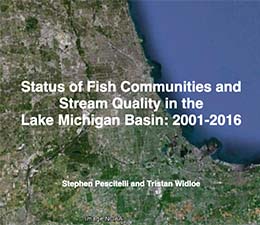Choose another river
Lake Michigan Basin - Chicago and Calumet Rivers
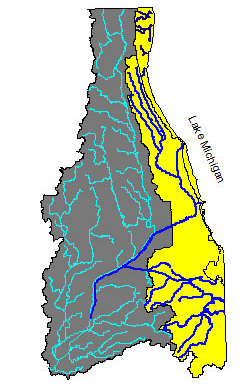
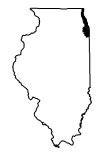
Figure 1: Location of the Lake Michigan and adjacent Des Plaines River Watersheds
Description: The Lake Michigan Basin in northeastern Illinois includes the most densely populated and heavily industrialized areas of Illinois. The waterways consist of a combination of both man-made and modified stream channels. In fact, few of the streams in the Lake Michigan Basin actually drain to Lake Michigan due to massive realignments which occurred in the late 19th and early 20th centuries; re-directing flows to the Illinois River. Though the waterways were once severely polluted, advancements in both wastewater treatment and stormwater management have resulted in improved conditions. Renewed interest in active and passive recreation following these advancements has resulted in revision of the standards and use designations by the Illinois Pollution Control Board (IPCB 2015). Although much of the system remains impaired by continued water quality and habitat issues, the expanding list of fish species indicates potential for the system. Planned expansion of the Deep Tunnel Project will help address remaining problems caused by combined sewer overflows (MWRD.org). Habitat improvements have been ongoing with the removal of the West River Park Dam on the North Branch, planting of emergent aquatic plants on the North Shore Channel, and installation of Channel Catfish spawning structures throughout the system (https://www.chicagoriver.org/)
Fishing Access: Anglers have increased use of the waterways as they continue to improve. Bank fishing has become more common especially on the larger waterways with access at locations throughout the Loop and on the South Branch (https://www.chicagoparkdistrict.com/). West River Park at the confluence of the North Branch is a popular spot. There are abundant access points on the upper North Branch for fishing and canoeing in Cook (https://fpdcc.com) and Lake Counties (https://www.lcfpd.org). Many of the larger channels are boatable with a ramp at Western Avenue on the South Branch and several on the Little Calumet and Calumet Rivers (https://fpdcc.com).
Status of the Fishery: The Lake Michigan Basin is sampled every five years at the locations shown in Figure 2. Additional sampling occurs for selected sportfish and as part of the Asian Carp Monitoring Program. Largemouth Bass and Bluegill are the most abundant species throughout most of the waterways, with electrofishing catch rates averaging near 20 fish per hour for both species. Catch rates for Largemouth Bass in the Chicago River system are typically higher in the North Shore Channel, and North Branch near West River Park. In the Calumet River system to the south, they are more readily found in areas with woody debris, rocky shorelines, near bridges, and also around MWRD aeration stations. Most of the Largemouth Bass are less than 12 inches in length but a few larger individuals up to 20 inches have been collected. Bluegill in the 6 to 10 inch range are relatively common, especially in the Calumet River system. Pumpkinseed Sunfish are common in the Chicago River system, but are generally smaller than Bluegill. A few other sportfish species are present, however, in relatively low in abundance, including Channel Catfish and Smallmouth Bass. Rock Bass are showing up in the North Branch, as well as the rare pike and occasional crappie.
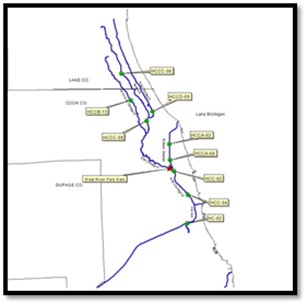
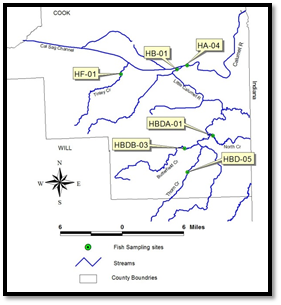
Management Activities: IL DNR has been involved in a number of habitat improvement projects (Figure 3), addressing one of the limiting factors throughout the Lake Michigan Basin (www.chicagoriver.org).
- Installation of 400 Channel Catfish spawning and fish habitat structures at six locations in the Chicago and Calumet River systems. Funded by Chi Cal Project in cooperation with the Friends of the Chicago River.
- Planting of 5,000 emergent plants, Water Willow and Lizards Tail, in the North Shore Channel to improve fish habitat and reduce erosion. Funded by Chi Cal Project in cooperation with the Friends of the Chicago River and Cook County Forest Preserve District.
- Reconnection of Mill Creek to the Cal Sag Channel, providing a fish recruitment source for repopulation of a diminished fish community in Mill Creek. Funded by Chi Cal Project in cooperation with the Friends of the Chicago River.
- Removal of the West River Park Dam, reconnecting 20 miles of the upper North Branch to the lower North Branch and North Shore Channel. Partners: Army Corps of Engineers, MWRD, Friends of the Chicago River, Chicago Park District.
Habitat Projects in the Chicago Area Waterway System
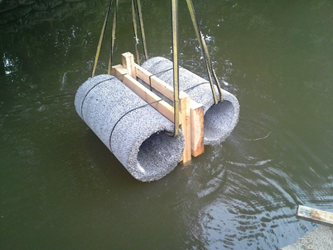
Channel Catfish spawning structures
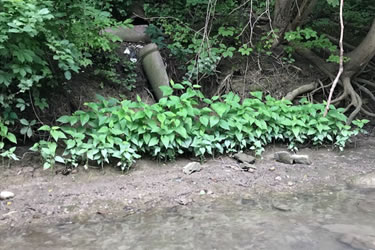
North Shore Channel planting project
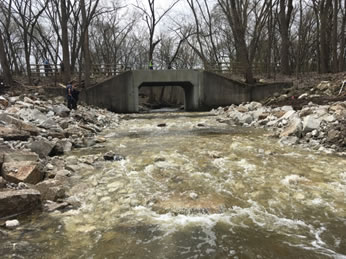
Mill Creek reconnection project

West River Park Dam removal


